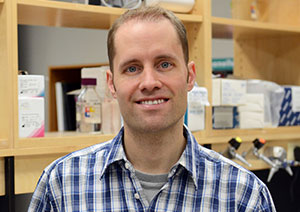2017 CIHR Early Career Investigators in Maternal, Reproductive, Child and Youth Health Grant Profiles
| Profile: |
|---|

Measuring what matters: Integrating patient-reported outcome measures into clinical practiceName: Samantha J. Anthony Survival rates demonstrate pediatric transplantation as an effective medical intervention for patients with end-stage organ failure. However, there is increasing acknowledgment that survival rates cannot be the gold standard when considering the efficacy and overall effectiveness of transplantation. While the use of objective outcome metrics (i.e. morbidity and mortality) has dominated transplantation science, subjective evaluation of pediatric solid organ transplantation from the patient perspective is essential. Patient-reported outcome measures (PROMs) are vital to address the burden of disease and are defined as: “any report of the patient’s health condition that comes directly from the patient, without interpretation of the patient’s response by a clinician or anyone else”. Empirical data indicate that systematic collection of PROM data enhances patient-clinician communication, patient engagement, and shared-decision making while improving self-care management and health outcomes, including patients’ quality of life. The overarching objective of this program of research is to establish the optimal approach to integrating PROMs systematically and effectively into clinical practice to improve the outcomes and well-being of pediatric transplant patients and families in Canada. Dr. Samantha J. Anthony is a Health Clinician-Scientist at the SickKids Research Institute, an Assistant Professor (status only) in the Factor-Inwentash Faculty of Social Work at U of T and an Investigator with the CDTRP. Her program of research focuses on establishing an evidence-based foundation for successful psychosocial adaptation and enhanced quality of life for individuals with chronic disease, with an emphasis on pediatric transplantation. Website: Anthony Lab |

Mitigating cisplatin-induced ototoxicity in childhood cancer treatment through applied pharmacogenomicsName: Amit P. Bhavsar Over half of children who receive cisplatin treatment for childhood cancers permanently lose their hearing. This hearing loss makes it more difficult for these children to learn and socialize, which has a long-term negative impact on their quality of life. Genetic differences between children can influence whether they develop hearing loss from cisplatin. We are using pharmacogenomics, to study how these differences alter toxicity to cisplatin treatment. Our goals are to use this understanding of genetic variation and treatment toxicity to develop better tools to i) predict the risk of hearing loss and ii) prevent hearing loss without compromising cisplatin’s anti-cancer effects Our pharmacogenomic study identified a gene of interest that normally plays a role in defending cells from infections. We are focusing our efforts on developing a rapid test that identifies a specific genetic change in this gene and provides a better estimate of the risk of hearing loss. We are also testing the role of this defence gene in cisplatin toxicity in cells similar to those found in specific structures of the ear. By understanding this role we can develop treatments to prevent toxicity in the ear and preserve hearing. Dr. Bhavsar obtained his PhD in Biochemistry from McMaster University. He completed postdoctoral training at the Michael Smith Laboratories, UBC and was a research associate at BC Children’s Hospital Research Institute. Dr. Bhavsar was appointed Assistant Professor in the Medical Microbiology and Immunology Department at the University of Alberta in 2017. Twitter: @AHHMUAlberta Publications:
|

Non primary cytomegalovirus infections in pregnancyName: Isabelle Boucoiran Cytomegalovirus (CMV) is the most frequent cause of congenital infection. Preconceptional immunity against CMV provides only incomplete protection against intrauterine transmission. Our objectives are (1) To assess the frequency of CMV congenital infection despite previous immunity in pregnancy and explore its risk factors, (2) To evaluate the frequency of CMV reinfections among women who had a congenitally infected child despite CMV immunity at the beginning of pregnancy. We will use the data and samples of the biobank Grossesse en Santé (Quebec). Improved knowledge of CMV infection in pregnancy will help identify new targets for the prevention of congenital CMV infection. Moreover, the findings could have direct impact on the policy of preventive reassignment or withdrawal from work of pregnant workers currently in place in Quebec. As a clinician-researcher of the “Fond de Recherche du Québec - Santé », Dr Boucoiran’s main research interests are infectious diseases in obstetrics-gynecology and maternal-fetal medicine. Publication: CMV non-primary infection in pregnancy |

One year of brain maturation following a preterm birthName: Marie Brossard-Racine Children born very preterm [VPT] (<32 weeks gestational age) are at a greater risk of presenting with lifelong developmental difficulties. One possible explanation for the presence of these difficulties stems from the hypothesis that brain development of VPT infants is delayed. Nevertheless, how much the brain adapts and whether it catches up during its most active period of development that is the first few years of life remains to be determined. A greater understanding of the core brain characteristics of abnormal neurodevelopmental profiles and the identification of critical time periods of brain plasticity could provide specific targets for early intervention strategies tailored to this at-risk group. We therefore propose to characterize and compare in vivo brain maturation using quantitative magnetic resonance imaging techniques during the year that follows corrected term equivalent age between VPT and healthy term-born controls. Understanding how the brain grows and adapts during this active time of maturation will subsequently help us better plan early targeted care for VPT infants throughout this sensitive period. Our long-term goal is to optimize neurodevelopment in this highly vulnerable group. My research program aims to better understand the underlying mechanisms of function and dysfunction in children with neurodevelopmental disorders. My research approach combines advanced quantitative Magnetic Resonance Imaging techniques with clinically relevant standardized evaluations to promote early detection of non-optimal brain and/or functional development in at-risk pediatric populations. Twitter: @ResearchinRehab Website: Advances in Brain and Child Development Research Laboratory |

Infants born to women with disabilities: Health and health careName: Hilary Brown In Canada, one in 10 women of childbearing age has a disability. Women with disabilities experience high rates of poverty and poor access to health care, and research is beginning to show that these factors increase their risk for pregnancy complications. However, there is little research examining the health of their infants. The aim of this study is to compare access to health care, health, and mortality among infants born to women with and without disabilities. We are using data collected from Ontario medical records and documentation on disability support program recipients to identify all infants born to women with and without disabilities in Ontario. We are comparing rates of well-baby visits, emergency department visits, hospitalizations, and mortality between these two groups and are studying specific factors (e.g., poverty, absence of a regular health care provider) that explain any increased risk among infants of women with disabilities. Our findings will improve the health care delivery system by providing information needed to create tailored supports for women with disabilities and their infants. Because women with disabilities represent a growing maternal population, our research could have a significant impact on the health of Canadian infants. Hilary Brown, PhD, is an Assistant Professor in the Interdisciplinary Centre for Health & Society at the University of Toronto Scarborough. Her research program, funded by CIHR and the U.S. National Institutes of Health, explores the impact of maternal disability and chronic disease on preconception, pregnancy, and child health outcomes. Twitter: @hilarykbrown |

Early movers: The role of physical activity and sedentary behaviour in the healthy growth and development of infantsName: Valerie Carson The first five years of life are a critical period of development laying the foundation for life-long health. Regular physical activity and minimal sedentary behaviour enhances growth and development. Dr. Carson co-led the development of new Canadian 24-Hour Movement Guidelines, released in 2017. As part of the process, evidence gaps were identified to stimulate future research. Her study is addressing identified gaps by examining the long-term associations of physical activity (tummy time) and sedentary behaviour (screen time, reading, strollers, etc.) in infants with their gross motor skills and their achievement of gross motor milestones in the first 18 months of life. Parents of infants in Edmonton, Alberta (n=250) are completing a questionnaire regarding infant physical activity, sedentary behaviour, and gross motor skills when their infant is 2, 4, and 6 months old. Parents are also recording the gross motor milestones their infant reaches over the first 18 months of life. A sub-sample of 115 parents are also completing time-use diaries at 2, 4, and 6 months and their infant’s gross motor development is being objectively-measured at 6 months. Findings will advance knowledge in an under-researched segment of the pediatric population, informing updates to guidelines and health promotion initiatives. Dr. Valerie Carson is an Associate Professor at the University of Alberta and a CIHR New Investigator. She has expertise in growth and development benefits, determinants, and measurement of physical activity and sedentary behaviour in young people (birth to 17 years). Currently, her research targets children of the early years (0 to 5 years). Twitter: @ValLCarson Websites: |

Perpetually, Potentially, Pregnant: “Women of Childbearing Age” in public health policy and biomedical researchName: Alana Cattapan The concept of "women of childbearing age" is ubiquitous in public health initiatives and biomedical research. The understanding that women's reproductive potential can and should make them a site of study is often taken for granted in the name of protecting fetal health. There are, however, many women who are not planning to reproduce, or who are not physiologically capable of conception or pregnancy and who may be of "childbearing age." Furthermore, there are important roles for men, for the state, and for the private sector in the protection of fetal health, despite an ongoing and disproportionate focus on women. “Perpetually, Potentially, Pregnant” is a three-year project studying the emergence of “women of childbearing age” as the subjects of public health policy and biomedical research, focusing on the Canadian context. Using document analysis and interview research, it examines how the concept of “women of childbearing age” came to prominence to inform strategies that can address women’s reproductive autonomy in its wake. The goal of the study is to improve understanding of fetal health as a collective endeavour, and to challenge the uncritical use of discourses that reinforce the idea that women's health and decision-making are inherently matters of reproduction. Alana Cattapan is an Assistant Professor at the Johnson Shoyama Graduate School of Public Policy and an Associate Member of the Department of Community Health and Epidemiology in the Faculty of Medicine at the University of Saskatchewan. Her research examines gendered inclusion in policymaking, focusing on the governance of reproduction. Twitter: @arcattapan Website: Perpetually, Potentially, Pregnant |

Prognostic Value of Urinary Renal and Vascular Biomarkers in Hypertensive Pregnant WomenName: Anne-Marie C. Côté Hypertensive disorders of pregnancy affect 39,000 women/year in Canada. Preeclampsia, the most severe, occurs in 1 out of every 20 pregnancies. Preeclampsia is a leading cause of maternal complications and is tightly linked to women’s kidney health. Appearance of higher levels of proteins in the urine of women during pregnancy can be a red flag in the clinic. Indeed, it may impact a wide range of healthcare decisions for pregnant women. Examples of such decisions are those concerning hospitalization and longer-term recommendations after delivery, such as counselling of women on their future risks of hypertension, vascular and kidney diseases later in life. Current approaches to detect and quantify proteins in the urine of women during pregnancy are unfortunately unreliable. More specific and sensitive kidney health markers are urgently needed to help better predict adverse outcomes in hypertensive pregnant women who are investigated for preeclampsia. Our research project’s goal is to help address this unmet need. To do so, we propose to compare the relative predictive values of testing for albumin (a specific protein) versus standard protein testing in urine. We also propose to focus on kidney and vascular health marker profiles, in order to find new ways of better predicting the occurrence of adverse pregnancy outcomes in hypertensive pregnant women who are investigated for preeclampsia. Future perspectives include transferring our results into clinical practice to help healthcare. This will ultimately contribute to identifying the hypertensive pregnant women who are at high risk of complications, and to gain further insight into their longer-term vascular and kidney risks. A physician with specialized training in nephrology and complementary training in obstetric medicine, Dr. Côté completed her clinical and research training at the BC Women’s Hospital. Her research interests focus on renal and urinary biomarkers in hypertensive disorders of pregnancy. Her research program is perfectly aligned with her work in the clinic with hypertensive pregnant women. Twitter: @USherbrooke Publications:
|

Prevention of postpartum haemorrhage: addressing critical knowledge gaps for the use of tranexamic acidName: Rohan D’Souza In 2010, 6.2% of pregnant women in Canada suffered from postpartum haemorrhage (excessive blood loss at childbirth) and 5/1000 required a blood transfusion, which has its own risk. These numbers have been steadily increasing since 1991 and stopping this trend is a major health priority both in North America and worldwide. Tranexamic acid is a medication that has been shown to reduce blood loss in trauma patients and those undergoing major surgery. However its use to prevent postpartum haemorrhage is still not adequately studied. If effective at reducing blood loss following childbirth, this affordable and widely- available medication could improve health of women and reduce the need for blood transfusions not just in Canada, but all over the world. However, before a large trial is conducted, we need to address three important gaps in knowledge - (1) what is the correct dose of this medication after childbirth, (2) should we administer this medication to all women or only to those at increased risk for blood loss and (3) is a large trial of this kind feasible. This research aims to systematically answer these three important questions in preparation for conducting the large trial. Maternal-Fetal Medicine Physician, Mount Sinai Hospital, Toronto; Assistant Professor of Obstetrics & Gynaecology, University of Toronto; Clinician-Scientist, Lunenfeld-Tanenbaum Research Institute, Mount Sinai Hospital, Toronto; Fellow, Royal College of Obstetricians & Gynaecologists (UK). Twitter: @SingingOB Website: Tranexamic Acid for Prevention of Postpartum Haemorrhage: a Dose-finding Study |

Specialized pro-resolving mediators: A novel therapeutic approach for the treatment of Duchenne muscular dystrophyName: Nicolas Dumont Duchenne muscular dystrophy is a severe disease characterized by progressive and irreversible muscle wasting. The disease is caused by a genetic mutation leading to the loss of expression of dystrophin, a structural protein important for muscle fiber stability. Moreover, we recently showed that dystrophin also regulates the function of muscle stem cells, which are responsible for muscle repair. Therefore, our lab investigates new therapeutic approaches that target muscle stem cells to mitigate the disease. To date, glucocorticoids are the only drugs that can temporarily slow down muscle wasting in Duchenne muscular dystrophy by dampening the chronic inflammatory process; however, they also have detrimental side effects that impair muscle stem cell function and stimulate long-term muscle wasting. Therefore, there is room for improvement and for the development of a more efficient therapy for this severe disease. Our research program investigates a new class of mediators for the treatment of Duchenne muscular dystrophy. These molecules have a potent ability to resolve inflammation, and they could directly stimulate muscle stem cell activity and promote muscle healing. With this dual ability, these mediators have a higher therapeutic potential compared to the standard treatment, which could ultimately help to preserve muscle function overtime. Dr. Dumont acquired a vast expertise in skeletal muscle physiopathology during his PhD (Université Laval) and post-doc (University of Ottawa). He is an assistant professor at the Université de Montréal since 2016. His lab is located at the CHU Sainte-Justine where his team study the function of muscle stem cells in muscle diseases. Website: Nicolas Dumont |

The immune pathogenesis of neonatal infection: Relevance to digestive healthName: Shokrollah Elahi As compared to adults, the susceptibility of infants to infection is a major global health burden and immunological challenge. This is followed by the increase in immune disorders such as food allergies, inflammatory bowel diseases (IBDs) and autoimmune diseases in children aged 0 to 9. Understanding how immune mechanisms operate in infants is key to developing new approaches in our quest to improve global health in this vulnerable population. The challenges infants face, with infections and immune disorders may be two-sides of the same phenomenon. Recently, we have shown that newborns are physiologically enriched with immature red blood cells (CD71+ erythroid cells). Although, these cells suppress the immune system and are associated with poor immune responses to pathogens/vaccines, they play a crucial role in early life for swift adaptation to the commensal microorganisms. Thus, understanding how immune mechanisms operate in infants as well as the cross-talk between immune cells and commensal bacteria, are crucial for developing new health interventions for some of our most vulnerable populations. My studies will provide novel insight into mechanisms that govern the immunological differences seen in early life that result in extreme vulnerability to infections or autoimmune diseases. Shokrollah Elahi is an Associate Professor of Immunology with expertise in Immunoregulation, HIV, Cancer and neonatal immunology, in particular the cross-talk between immune cells and microbiome. Dr. Elahi is well positioned to successfully merge various fields in the pursuance of novel and paradigm shifting approaches to health care solutions. Publications:
|

Novel therapeutics to improve survival and reduce toxicity in young patientsName: Kolja Eppert Many patients with childhood acute myeloid leukemia (AML) do not respond to therapy. This is in spite of the intense and toxic nature of the treatment, which can lead to developmental impairments, long term cardiac dysfunction, fertility issues and even secondary cancers later in life. This project will identify new anti-leukemic drugs, which may lead to improvements in outcome and reduced toxicity in patients. These drugs target the rare cells that contribute to treatment failure, the leukemic stem cells (LSCs). LSCs act somewhat like normal stem cells, although cancerous, and are the ‘root’ of the disease - they need to be eliminated to achieve a cure. We have taken data on the activity of genes in LSCs and regular blood cells and combined it with data sets on how drugs cause changes in gene activity to identify compounds that we predict would specifically eliminate LSCs. We have directly tested many of these compounds and found a subset that do preferentially target LSCs in human leukemia. We are studying this subset of compounds in depth to determine how well they work against multiple subtypes of AML, how they eliminate leukemia, and how safe they are. Dr. Eppert, PhD, was trained at the University of Toronto in cancer genetics and stem cell biology. He is currently an associate professor in Pediatrics at McGill University where he studies the biology of normal and cancerous blood stem cells. Website: Kolja Eppert |

Integrated view of the preterm birth syndromeName: Sylvie Girard Preterm birth is the most important cause of child mortality and surviving newborn can have life-long sequalae, such has neurodevelopmental disorders. Preterm birth is a syndrome, meaning that there is multiple causes. These are still not fully understood, making the development of new diagnostic and therapeutic strategies for preterm birth very difficult. In order to better understand preterm birth, we decided to have an “integrated” approach in which we study and combine multiple layers of analysis of preterm birth. These include the mother (inflammatory profile and immune system); the placenta (function, inflammation, structural changes, analysis of the transcriptome) and the newborn (type of neonatal and postnatal complications). Integrating information from the mother, placenta and child will allow us to determine subgroups of preterm birth and identify which groups might benefit from therapeutic intervention (ex. anti-inflammatory treatment). This will also greatly help us better understand this very complex pathology which can have devastating impacts on the babies and their family. I am an assistant professor in Obstetrics & Gynecology with training in the fields of reproduction, brain development and immunology (particularly the study of inflammation and the immune response). I now combine these expertise to address how inflammation occurring during pregnancy will affect maternal health and especially the placenta and the development of the baby. |

Neuroprotective agents for cerebral malariaName: Michael Hawkes Malaria is the third leading cause of death in children globally. In Canada, we see about 400 cases per year, especially among new immigrants and travellers returning from the tropics. It mostly affects young children in sub-Saharan Africa, who are at risk of severe disease, death, and mental disability following infection. Cerebral malaria is a deadly complication which occurs when the brain is involved. Despite the world's best antimalarial drugs, the mortality rate is still about 20%, meaning that one in five children with cerebral malaria will die of their infection. Furthermore, 25% (one in four) children who survive cerebral malaria will be left with lasting brain problems. New treatment strategies are needed to reduce the number of deaths as well as the long term effects of cerebral malaria on the brain. We think that some newly licensed drugs for cancer and brain disorders can be used for an entirely different purpose: to protect the brain in cerebral malaria. This surprising re-purposing of new medications makes sense because these drugs target molecules which govern the leakiness of vessels and brain swelling. By targeting these molecules, we think that we can improve outcomes in cerebral malaria. We want to test these drugs in 2 ways: a model of the blood brain barrier using cells in a "petri dish," and an animal model of disease. We will test these drugs to see if they can protect the brain by stabilizing the "blood-brain barrier" which separates the brain cells from the bloodstream. If we find promising molecules, this will be significant because it will suggest new treatments that could be tried in clinical trials of children with cerebral malaria. |

Discovering novel biomarkers for juvenile arthritis: focus on platelet signalingName: Hugh Kim Juvenile arthritis is a very serious disease that affects over 300,000 children and teenagers in North America and causes severe pain, physical deformities and confers a risk of long-term disability. While it is known that juvenile arthritis is characterized by chronic inflammation of the joints, it is currently impossible to accurately identify those children who may be at highest risk for future disease. In chronic diseases such as arthritis, signaling molecules called cytokines are largely responsible for tissue inflammation and destruction. Platelets are tiny cells in the blood that control blood clotting but also release cytokines that can promote inflammation during arthritis. The purpose of this project is to study platelet activity in patients with juvenile arthritis in order to determine (1) whether platelet-derived cytokines contribute to juvenile arthritis and (2) if these molecules can be used as markers to predict the clinical course of the disease. An improved understanding of the molecular mechanisms underlying juvenile arthritis will eventually lead to improved clinical tools for diagnosing, prognosticating and treating this debilitating disease. Hugh Kim is an Assistant Professor at The University of British Columbia (UBC)’s Faculty of Dentistry, with a cross-appointment to the Department of Biochemistry and Molecular Biology. His laboratory is focused on platelet signaling in inflammation, and is part of the UBC Centre for Blood Research and Life Sciences Institute. |

Exploring Indigenous women’s maternity experiencesName: Jennifer Leason Keesis Sagay Egette Kwe (First Shining rays of Sunlight Woman) Increases in Indigenous populations coupled with maternal-child health disparities, inequities and adverse realities demonstrate the need to better support Indigenous mothers, infants, families and communities. Indigenous maternity experiences research can help identify maternal child health strengths and resilience, gaps, barriers and needs. Unfortunately, the previous maternity experiences survey (PHAC 2009) excluded First Nation women living on reserve, institutionalized women, and women who were not living with their infants a the time of the survey. In addition, the questions posed do not accurately reflect the perspectives, experiences and complex contexts of Indigenous women and their communities (Leason 2017). Through Indigenous and decolonized community-based research, Indigenous women, birth partners, Elders and communities will contribute to the co-creation of a culturally and contextually relevant Indigenous maternity experiences survey (IMES). Narratives and cultural orientations will inform survey questions that are inclusive, respectful and representative of their unique and diverse perspectives. It is anticipated that the research will help to inform maternal-child health indicators and priorities, as well as identify gaps and barriers. The goal is to provide evidence for advocacy/action, strategic decision-making, policy, and programming to improve maternal child health and healthy life trajectories. Dr. Leason is Saulteaux – Métis Anishinaabe and a member of the Pine Creek Indian Band, Manitoba. Dr. Leason holds a PhD from the University of British Columbia (Okanagan) in Interdisciplinary studies. Her interdisciplinary training and research includes Indigenous studies, critical medical anthropology, epidemiology and women/gender studies. Twitter: @DrLeason Website: Jennifer Leason Publications:
|

Improving maternal and perinatal outcomes in high risk mothersName: Sarka Lisonkova The average maternal age, obesity, multiple pregnancy, and chronic diseases such as diabetes and hypertension continue to increase in Canada. These demographic trends highlight the need for increasingly complex obstetric care with careful prenatal monitoring and timely obstetric intervention if necessary. As maternal death is a very rare event, preventive efforts need to focus also on potentially life-threatening maternal conditions and identification of women who are at high risk, including those of older maternal age, overweight or obese, and those with twins/triplets or underlying chronic diseases. Risk factors often co-exist, therefore the combined effects and interactions between these conditions need to be addressed and quantified carefully. Some severe maternal conditions (e.g., eclampsia or sepsis) are potentially preventable. We propose to examine these specific types of severe potentially life-threatening maternal morbidity in relation to older maternal age, high body mass index and underlying chronic conditions using data on all births in Canada in the past 10 years. We will quantify the risk of severe maternal morbidity by developing a score system that will accurately distinguish between high, moderate, and low risk women. This score will help, for example, women in rural areas to decide about transport to higher-level obstetric care. Sarka Lisonkova, MD, PhD, is an Assistant Professor in the Department of Obstetrics and Gynaecology, University of British Columbia, and a Michael Smith Scholar in Health Research. Dr. Lisonkova’ research focuses on perinatal epidemiology and maternal, fetal and neonatal health, and health services research. Twitter: @sarkalis Publications:
|

Sensory Cilia Mutations Affecting Motile Cilia in Ciliopathy DisordersName: Vito Mennella The cells lining the airway have tiny hair-like structures named motile cilia. With coordinated movements they move bacteria and particles out of the airway and send signal from the environment to the inside of the cell. Another type of cilia is called sensory as it is like a single antenna that sends and receives messages from the environment. These single antennas are present in almost every cell of the body. Cilia are essential to health, children with defective cilia develop ciliopathies, severe diseases affecting 1:2000 children that can lead to blindness and severe lung disease. We accumulated a lot of basic research information about cilia, but we do not really know how they cause disease. In this proposal, we will study nasal cells of normal people and patients affected by Retinitis Pigmentosa (RP) caused by a sensory cilia defect. Some patients with RP have lung problems similar to patients with motile cilia defects, despite no known defect in the motile cilia. We don't know why. We will define the detailed structure and function of the new cilia in normal people and in people with RP using our new very high resolution imaging strategy. The RP patients will receive a detailed lung function assessment. This research is highly innovative because it applies basic new imaging technologies, capable of visualizing molecules in cells more clearly than ever before, to better understand an important clinical problem. Our findings may lead to a paradigm change in the way scientists currently think about sensory and motile cilia, and will likely improve our understanding of many other conditions related to cilia function. |

Survival, recurrence and obstetrical outcomes after pregnancy-associated and postpartum cancerName: Amy Metcalfe The rate of cancer during pregnancy and in the postpartum period (i.e. the year after pregnancy) is increasing. Multiple studies have found that women diagnosed with breast cancer during pregnancy or postpartum have worse survival than other women with breast cancer. It is unknown if this survival disadvantage also applies to other forms of cancer diagnosed during this time period. Additionally, there is little evidence to guide the management of current pregnancies when women have cancer or planning of future pregnancies in women after cancer treatment. This study will use population-based registry and health administrative data to examine survival and recurrence risks following all types of cancer diagnosed during pregnancy or postpartum and will use advanced statistical techniques to determine what factors are associated with improved prognosis. Additionally, amongst the subset of women who conceive following a cancer diagnosis, we will examine the optimal timing of pregnancy to minimize harms to the mother and the infant. Amy Metcalfe, PhD, is an Assistant Professor at the University of Calgary and a Canadian Institutes of Health Research New Investigator Awardee. Her program of research focuses on examining the impact of chronic disease on maternal and fetal health; evaluating the ability of alternative models of prenatal care to improve disease control and obstetrical outcomes; and assessing the risk of long-term disease complications following pregnancy. Twitter: @AmyMetcalfePhD Publications: Amy Metcalfe |

The paternal contribution to neurodevelopmental and metabolic outcomes in the childName: Tuong-Vi Nguyen This proposal focuses on: (1) how paternal factors can affect brain and endocrine function of the child; and (2) whether the impact of paternal factors extends beyond fetal life up until middle childhood (i.e. 6-8 years of age). Pre-conception paternal factors (factors present before sperm meets egg) may directly cause alterations in the molecular machinery regulating the expression of genes related to both brain and endocrine function in sperm. Perinatal paternal factors may further impact the child’s brain and endocrine function through their indirect influence on perinatal maternal depression and anxiety. Endocrine disruption during development significantly increases the risk of impulse control disorders such as attention-deficit hyperactivity, suggesting that paternal effects on brain and endocrine function of the child can have long-term behavioral impact until middle childhood. Understanding the paternal contribution to the child’s brain and endocrine development will help tailor preventative public health interventions. Indeed, paternal lifestyle changes made even a few weeks before conception could make a critical difference down the line in vulnerable children. Hence, anticipated results from this project are likely to have a strong public health impact and can be used to counsel fathers about modifiable risk factors as early as the pre-conception period. NPA Nguyen is a clinician-researcher and Assistant Professor in the Departments of Psychiatry and Obstetrics-Gynecology at McGill University and Director of the Reproductive Psychiatry Program at the McGill University Health Centre (MUHC). She is a graduate of the National Institutes of Health (NIH) in Behavioral Endocrinology and Integrative Neuroimaging and a Fonds de Recherche Santé Québec (FRSQ) Clinician Research Scholar Junior 1. Her work focuses on the impact of endocrine changes on brain and behavior in humans, during both developmental and reproductive periods. Website: Tuong-Vi Nguyen, M.D., M.Sc. |

Allogeneic stem cell therapy to treat acute liver failure in infants, children and adolescents without the need of immunosuppressionName: Massimiliano Paganelli Acute liver failure (ALF) in children and adolescents has a poor outcome, with only 50% of patients surviving without liver transplantation. There is an urgent need for effective liver support systems able to replace liver functions for the time needed for the patient’s liver to regenerate, or for a suitable donor to be found. We developed a stem cell-based solution to be used as a bridge to liver regeneration or transplantation. Starting from stem cells and taking advantage of innovative biomaterials, we generated an encapsulated liver tissue performing the functions of the human liver. Once transplanted into a patient with ALF, such a liver tissue is expected to purify his/her blood from toxic substances and to synthesize proteins needed for vital functions, improving survival and preventing complications. The biomaterial protects the embedded cellular aggregates (“organoids”) from the immune system of the recipient, thus eliminating the risk of rejection and the need for immunosuppression. With this project we are assessing the safety of such a stem cell-derived liver tissue and evaluating its efficacy in mouse models of ALF, in order to develop a regenerative medicine product with the potential to treat thousands of infants, children and adolescents worldwide. Massimiliano Paganelli is assistant professor at the Université de Montréal and pediatric hepatologist and principal investigator at CHU Sainte-Justine. His laboratory of Hepatology and Cell Therapy focuses on human pluripotent stem cell-derived 2D and 3D models of liver disease and on the use of liver organoids and biomaterials to treat liver failure. He is a FRQS Junior 1 clinician-scientist, a Stem Cell Network Investigator and he recently received a CIHR Project grant. Massimiliano deposited 3 patents and co-founded the regenerative medicine start-up Morphocell Technologies Inc. Twitter: Website: Paganelli Lab |

Immune regulation of placental blood flow and fetal healthName: Stephen Renaud My lab focuses on development of the placenta. The placenta is the lifeline between a mom and her baby during pregnancy. In some pregnancies, the placenta does not form properly, which can lead to serious complications that are leading causes of sickness and death of moms and babies. We know little about why the placenta does not develop properly in these cases. My lab has found that immune cells in the uterus shape the way placentas develop. Thus, we think that abnormal behavior of these immune cells may underlie defective placental development, and lead to pregnancy complications. This project will test the role of uterine immune cells in placental function, and assess whether abnormal behaviour of these cells disrupts proper placental development, leading to poor pregnancy outcomes and long-term deficiencies in health of offspring. Collectively, this project will test the applicability of targeting uterine immune cells to improve placental and fetal health, with the ultimate goal of devising strategies to enhance the health of moms and babies during pregnancy and beyond. I completed a PhD at Queen’s University in Kingston, and then pursued a post-doctoral fellowship at the University of Kansas Medical Center in Kansas City. I am currently an Assistant Professor at the University of Western Ontario, and a Scientist at the Children’s Health Research Institute in London, Ontario. Twitter: @SJRenaud79 Websites: |

Bridging the gap to prevent adverse events between pediatric and adult diabetes careName: Rayzel Shulman This study aims to help individuals living with type 1 diabetes (T1D) to achieve better diabetes control around the time they transition from pediatric to adult care. This project will involve delivery of feedback reports to pediatric diabetes teams about the outcomes of patients who were recently transferred to adult care. Pediatric teams will be coached in a series of webinars about how to use these reports along with the “Got Transition” structured set of six core elements of quality transition care to encourage local transition-related quality improvement initiatives. We believe that measuring and providing continuous feedback to care teams that is aligned with a transition practice standard will improve T1D control and the quality of transition care for people with T1D. My research program is focused on developing and evaluating health services interventions to improve health outcomes and the quality of care for youth living with diabetes as they transition to adult care. I am interested in developing and evaluating interventions that leverage existing population-level administrative datasets to inform health system change. Twitter: @rayzel_shulman |

Sleeping Soundly: Students as change agents to support healthy sleep habits at homeName: Kate Storey A good night’s sleep is key for happier, healthier kids. Sleep plays a vital role in achieving a healthy lifestyle, and is crucial to children’s development. Further, shorter sleep duration and poorer sleep quality are linked to poorer academic outcomes. The home and school are critical environments to shape healthy behaviours, and health promotion efforts have increasingly focused on the school setting. While several school-based initiatives have been implemented to support improved sleep among children, it is unknown if healthy sleep habits are being translated home. Children are powerful change agents for health behaviours, thus this research will examine if and how children initiate sleep habit changes at home. This research will also examine parents’ perspectives regarding sleep and if parental support at home reinforces school-based learning. Findings from children and parents will inform and strengthen existing school-based sleep promotion through an extensive stakeholder consultation. I am a passionate advocate for children’s health, and believe the path to wellness is through inspired youth. Taking a strengths-based approach, my research program focuses on the holistic assessment of school- and community-based strategies to promote health, prevent chronic diseases, and reduce health inequities. Twitter: @UAlbertaSPH Websites: Publications:
|

Pediatric acute respiratory distress syndrome: determining post-discharge outcomes, the effect of early diagnosis, and identifying inflammatory signatures to better understand disease mechanismName: Sze Man Tse Pediatric acute respiratory distress syndrome (PARDS) affects children of all ages with a severe lung injury needing respiratory support in the intensive care unit. The long-term consequences of PARDS are not well studied. It is also not know whether clinical or biological factors can predict long-term outcomes in these children. In this study, we are following a group of children with PARDS over the one year following their hospital discharge. We want to better characterize the outcomes of PARDS survivors, to examine whether subgroups of children with PARDS can be identified, and to determine whether an earlier diagnosis of PARDS using a computerized decision support system will improve the care of these children. We will also build a database containing information on children with PARDS linked to biological samples for future research. The results of this study will provide insight into the long-term outcomes of PARDS survivors and the mechanisms underlying this condition, and may change the way PARDS is currently diagnosed. Finally, the creation of a PARDS database will be a valuable tool for future interdisciplinary studies in this field. Dr. Sze Man Tse is a pediatric respirologist with a research interest in the long-term outcomes of children with acute respiratory illnesses and identifying factors that may predict these outcomes. She completed her pediatric respirology training at the Massachusetts General Hospital in Boston, USA and simultaneously obtained her Master’s degree in Public Health from the Harvard School of Public Health. Twitter: @smtrespmd |

Early neurodevelopment in the offspring of women enrolled in an RCT assessing the effectiveness of a nutrition+exercise intervention for healthy gestational weight gainName: Ryan J Van Lieshout Early brain development is vital to health and success in life. Since neurodevelopment begins at conception, it is not surprising that unhealthy maternal diet and physical inactivity during pregnancy have been linked to problems with regulating emotions in offspring. However, no experimental studies in humans have examined if a practical, structured maternal diet and exercise program can improve offspring emotion regulation. We will assess the 36-month-old children of the 200 women enrolled in the ongoing Be Healthy in Pregnancy study, a randomized controlled trial that examines the effectiveness of a nutrition+exercise intervention designed to promote healthy pregnancy weight gain in mothers. Half of mothers get a customized nutrition and walking program and the other half will receive usual pregnancy care. Observational, informant-reported, and physiological (measures of brain, parasympathetic nervous system, and stress) measures of offspring emotion regulation will be utilized. Since the ability of the brain to change decreases with age, pregnancy may be the most effective period during which brain development can be optimized. If neurodevelopment can be improved with a practical nutrition+exercise program for pregnant women, it could enable the prevention of emotional and behavioural problems in offspring and transform the developmental trajectories of Canadian children. Ryan is a psychiatrist with a PhD in research methods, the Canada Research Chair in the Perinatal Programming of Mental Disorders and the Albert Einstein/Irving Zucker Chair in Neuroscience at McMaster. He is interested in developing and studying perinatal interventions that can be used to optimize infant and child neurodevelopment. Publications:
|
- Date modified: